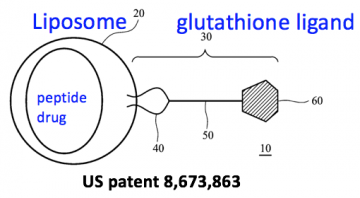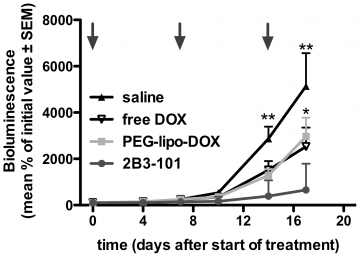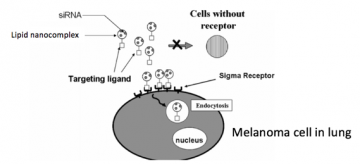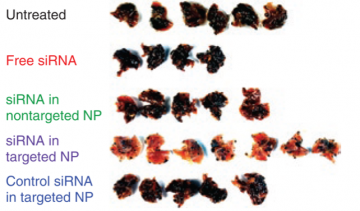Introduction
Liposomes allow for targeted drug delivery. By attaching a ligand, liposomes can become further targeted for a specific region of the body. In theory, this should improve drug delivery and efficacy of treatment or diagnostic testing. At the same time, it will help minimize adverse effects by preventing the drug from being delivered to non-targeted tissues and cells.
Targeted Delivery of Doxorubicin for Brain Cancer
Brain cancer can be an especially difficult cancer to treat because of the presence of the blood-brain-barrier. Glutathione is a tripeptide that is actively transported past the blood-brain-barrier. By creating a targeted liposome with a glutathione ligand, we can send potent anticancer agents, such as doxorubicin, to the site of the brain cancer and bypass issues of the blood-brain barrier. This product is currently in clinical trials.

Figure 1. Simplified illustration of an example liposome with attached glutathione ligand for tissue-specific targeting.

Figure 2. Mice were given either saline, free doxorubicin, pegylated liposomal doxorubicin or 2B3-101 (glutathione pegylated liposomal doxorubicin) at weekly intervals as indicated by the arrows. Tumor growth was measured via bioluminescence. Greater inhibition of growth was seen with the glutathione pegylated liposomal formulation. From Gaillard et al. PLOS ONE. 2014; 9(1): e82331. doi: 10.1371/journal.pone.0082331
Targeted Delivery of siRNA to Melanoma in Lung
siRNA was packaged inside a liposome and attached to a targeting ligand. In addition to using cationic lipids, which preferentially accumulate in the lung, an anisamide targeting ligand was used which has high affinity for sigma receptor, which may be overexpressed in certain tumors.

Figure 3. Illustration of how liposomes with targeting ligand will only bind to cells of interest. In this case, we are delivering siRNA only to melanoma cells in the lung via a targeting ligand specific for the sigma receptor, which will allow endocytosis of and siRNA delivery from the liposome. In theory, this should decrease off-target side effects of siRNA delivery.

Figure 4. Pictures of mice lungs were taken 10 days after treatment given. Metastases nodules are seen in black. Significant reduction of metastasis predominantly only seen with siRNA in targeted nanoparticles. From Li et al. Mol Ther. 2008 May; 16(5): 942-946